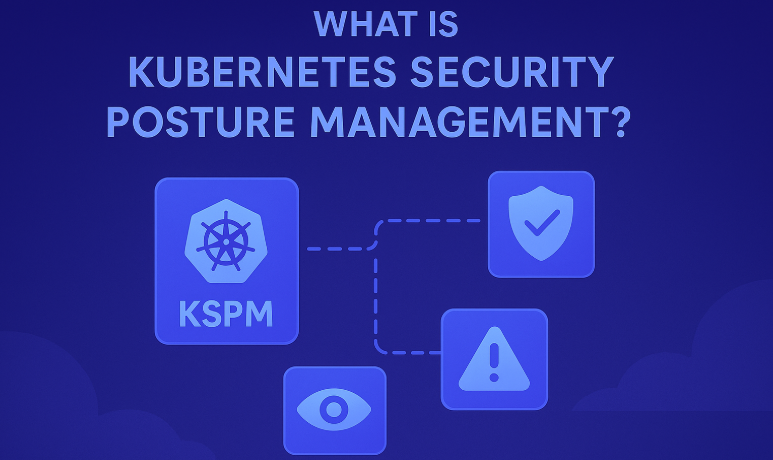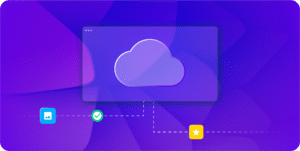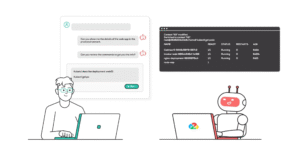Kubernetes is powerful, but security is complex, and establishing an effective Kubernetes security posture management is a challenge that DevOps teams need to solve.
Kubernetes (K8s) is the DevOps architecture underneath most modern, scalable, containerized apps. It’s fast, flexible, and scales well. But keeping it secure is hard work, partly because it’s an open-source platform.
DevOps teams need deep knowledge of the platform and how it integrates with other systems. Constant attention is essential to keep pods, clusters, and containers safe and compliant.
Key Takeaways
- Kubernetes security posture management involves reducing risk, maintaining visibility, and ensuring compliance.
- Automations using DuploCloud include network policies, admission control, drift detection, observability, and audit trails, making a huge difference to Kubernetes security posture management.
- DuploCloud’s AI-powered DevOps offers a unified platform that includes automated Kubernetes security management. It helps teams move faster without cutting corners on security or compliance.
What is Kubernetes Security Posture Management?
Kubernetes Security Posture Management (KSPM) is the practice of keeping your Kubernetes clusters secure over time. When it comes to KSPM, there are three main goals:
- Visibility: Understand exactly what’s running in your clusters, containers, and DevOps tech stack, and know how it’s all configured.
- Compliance: Meet industry security and compliance standards like SOC 2, HIPAA, and PCI-DSS.
- Risk Reduction: Find and fix any tech stack or cluster-based security problems before they can impact the whole organization.
KSPM is like Cloud Security Posture Management (CSPM) but with a strong focus on Kubernetes workloads, instead of the whole cloud infrastructure and applications. Combined, they will keep your entire stack secure.
Now, let’s look at how you can automate Kubernetes security with DuploCloud.
5 Ways to Automate Kubernetes Security with DuploCloud
For organizations already automating their Kubernetes security with DuploCloud, here are the five most common and powerful ways that our DevOps software can strengthen your cybersecurity.
1. Network Policies: Zero Trust Pod Isolation
Kubernetes NetworkPolicy controls how pods talk to each other. If you want to control the flow of traffic and data at the port level (OSI layer 3 or 4), then you need this to maintain compliance using TCP, UDP, and SCTP protocols.
NetworkPolicy is part of the Kubernetes platform. These protocols enforce least privilege access and stop cyber attackers from moving through your clusters and containers.
If you were to stick with manual policy management, you could expect the following problems:
- Mistakes can happen far too easily.
- Difficult to scale across a range of services and applications.
- It takes too much time to maintain, so it’s not cost-effective.
How DuploCloud makes KSPM easier:
- Creates network policies automatically.
- Provides security templates for the most common patterns in Kubernetes networks, clusters, and pods.
- Enforces zero-trust principles automatically, with minimal setup.
- Handles service segmentation without hours and hours of painstaking manual work.
Want to see how DuploCloud can transform your Kubernetes security posture? Benefit from a Free Demo Today.
2. Admission Control: Policy-as-Code Enforcement
An integral part of what DuploCloud does for Kubernetes is Policy-as-Code enforcement. For example, admission controllers like OPA and Kyverno check configurations before they run in your pods, clusters, and containers. Between DuploCloud, OPA, and Kyverno admission controllers, common security mistakes like the following can be prevented:
- Running containers as root;
- Missing resource limits;
- Privileged containers, and;
- Insecure image configurations.
How DuploCloud makes KSPM easier:
- Builds policy-as-code (PaC) automation into the platform;
- Adds compliance gates to CI/CD pipelines automatically (which was easily overlooked);
- Enforces best practices like resource limits and non-root containers, and;
- Blocks insecure deployments before they reach production.
- This is the best way to prevent something from being pushed live that could weaken the entire network.
3. Continuous Compliance and Drift Detection
KSPM needs ongoing monitoring. This should be 24/7 and automated, with alerts for manual action as required. Configurations change over time, and manual audits can overlook issues.
Manual audits are also slow and inconsistent. Even if done monthly, you can easily miss something that should’ve been fixed much quicker. Configuration drift is one of the most common issues, but there are numerous others.
How DuploCloud makes KSPM easier:
- Automates compliance controls for SOC 2, PCI standards, and HIPAA regulations;
- Comes with built-in logging and monitoring with Prometheus, Grafana, and Loki
- Creates audit trails automatically (far too difficult to do manually);
- Maps infrastructure to compliance controls using AI;
- Prevents configuration drift using GitOps and Terraform;
- Automatic alerts when policies are violated, keeping devs in the loop.
4. Observability and Metrics
Robust, proactive, and 24/7 observability is key to strong Kubernetes security posture management. You need metrics, logs, and traces to understand what’s happening in your clusters. This data helps with:
- Error budgets and reliability tracking
- Metrics-based alerting
- SRE-aligned monitoring practices
How DuploCloud makes KSPM easier:
The great thing about DuploCloud is that it packages observability tools into one suite. You get Prometheus, Grafana, Loki, and OpenTelemetry out of the box. This gives DevOps and cybersecurity teams immediate access to:
- Kubernetes cluster health dashboards;
- Automated policy compliance monitoring;
- AI-powered security alerting capabilities;
- No separate setup required. Monitoring comes as standard.
5. Compliance Reporting and Audit Evidence
Cybersecurity and compliance auditors need detailed proof that your systems are secure. As do C-Suite leaders. In most cases, this means having the following audit trail evidence:
- Configuration snapshots
- Dev team access logs
- Access control records
- Evidence of the levels of Encryption being used.
Pulling all of this together manually takes too much time and effort. Your team has better things to be getting on with.
How DuploCloud makes KSPM easier:
DuploCloud supports major compliance frameworks, including but not limited to the following: SOC 2, PCI-DSS, HIPAA, ISO, GDPR, and NIST. The platform:
- Infrastructure and compliance controls are automatically mapped together.
- Generates accurate audit trails without manual work.
- Creates audit reports that are automatically aligned to compliance standards.
- Tracks changes over time for audit purposes. Every audit will be up-to-date and accurate.
Now, let’s look at how all of that works in practice, and some best practices.
Putting It All Together: Maintaining Your Kubernetes Security Posture Management
Most teams don’t have the time, or Kubernetes knowledge or experience, to build all these security features manually.
DuploCloud gives DevOps and SRE teams a secure-by-default Kubernetes platform. From day one, you will benefit from:
- Network security controls;
- Policy enforcement;
- Compliance reporting;
- Monitoring and alerting;
- All automated and integrated.
Kubernetes Security Posture Management Best Practices
To get the most from KSPM, follow these five best practices:
- Start with defaults: Use secure configurations from the start.
- Automate everything: Manual processes don’t scale and almost always cause errors.
- Monitor continuously: Implement automated alerts for security and policy violations.
- Test regularly: Regularly validate that security controls work as expected.
- Document everything: Keep clear records for audits and for shared internal knowledge bases.
Secure Kubernetes at the Speed of DevOps
Kubernetes security posture management is a mission-critical part of DevOps. Manual tools and custom policies can’t and don’t scale with constant changes to development and security standards.
DuploCloud makes Kubernetes security built-in. Not bolted on as an extra. DevOps teams can:
- Eliminate manual infrastructure maintenance;
- Automate DevSecOps practices;
- Launch compliant environments in days, not months;
- Focus on building applications instead of managing cybersecurity.
Want to see how DuploCloud can transform your Kubernetes security posture? Benefit from a Free Demo Today.
Kubernetes Security Posture Management Frequently Asked Questions (FAQs)
Why is KSPM essential for Kubernetes environments?
Kubernetes security rules are complicated and always changing. AI-powered monitoring tools can automatically watch and enforce these rules. This helps reduce risks and meet compliance requirements. All of this without slowing down your development work.
How does DuploCloud help with Kubernetes security?
DuploCloud automatically handles security controls, enforces policies, and creates compliance reports. Unlike other platforms, you get secure Kubernetes settings right from the start without having to set them up manually.
Why is Kubernetes security so important?
Effective cloud security requires a comprehensive approach to managing your security posture across all cloud infrastructure components. Cloud security posture management (CSPM) tools help organizations monitor their Kubernetes cluster deployments and ensure container security standards are met throughout the cloud environment.
When running containerized applications on Kubernetes workloads, security teams must address multiple layers of security risk, from application security vulnerabilities to cloud misconfigurations that could lead to compliance violations.
Implementing cloud native security practices and following security best practices helps protect against common threats while maintaining compliance requirements. When continuously monitoring your cloud infrastructure for potential vulnerabilities and misconfigurations, organizations can maintain a strong security posture that protects both their containerized applications and underlying cloud resources from evolving security threats.
Do I need Kubernetes expertise to use DuploCloud?
No. DuploCloud handles the complex Kubernetes elements while keeping your systems secure. Your team can focus on building apps instead of managing infrastructure and security.
How does DuploCloud simplify Kubernetes Security Posture Management?
DuploCloud automatically takes care of many Kubernetes security tasks, including:
- Network policies;
- Admission control;
- Compliance monitoring; and
- Audit reporting.
DuploCloud helps to turn complex manual security processes into automated, manageable, scalable solutions.



